Among house plants, the indoor rose deserves special attention. By following simple instructions for creating optimal conditions for growing this flower, you can achieve good development of the crop and unsurpassed flowering beauty.
Description of the flower
The indoor rose is an evergreen shrub plant and belongs to the Rosaceae family. Its homeland is Southeast Asia. The stems of the plant are long and flexible. The leaves have a green color that varies from light to dark tones. Roses have been grown for several centuries. This popularity of the flower is facilitated by its high decorative qualities and the pleasant aroma that it emits. Today there are more than 200 species and about 25 thousand varieties of this crop. Roses can be grown in open ground, greenhouses and indoors.
Varieties that are suitable for home growing:
- Bengal rose. It blooms from May to October with minor interruptions. Unlike other varieties, it does not have a pronounced dormancy state; it does not shed its leaves in winter. Flowers reach 5 cm in diameter and can be white, pink or red. They remain fresh for up to 10 days.
- Chinese rose. Grows up to 30 cm in height. The bushes are highly branched. The color of the flowers is white or pink, their diameter reaches 2 cm. The plant has straight shoots and small leaves. The stems have the property of changing color as the crop grows. Young shoots are red, but become green over time.
- Baby Carnival is characterized by abundant flowering. The leaves are leathery, the buds are oval in shape. Flowers are lemon-chrome.
- Eleanor reaches a length of 30 cm. The shrub is straight. The flowers grow up to 3 cm in diameter and are pink in color. Elongated buds. This variety of rose produces a faint aroma.
- Pixie is a small plant up to 20 cm high. The flowers of this crop are not particularly large in size, their diameter is no more than 1.5 cm. The leaves are also small. Pixie is a frost-resistant variety that can withstand low temperatures.
- Coraline is a tall shrub, grows up to 35 cm. It blooms almost continuously. The plant has good branching. About 200 flowers bloom on one bush, each of which has a diameter of 3 to 5 cm.
Photo gallery: Rose varieties for home cultivation
Bengal rose will become a bright accent in the home
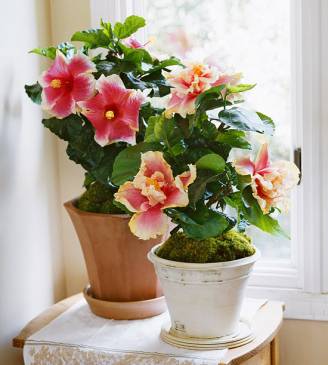
Original Chinese rose
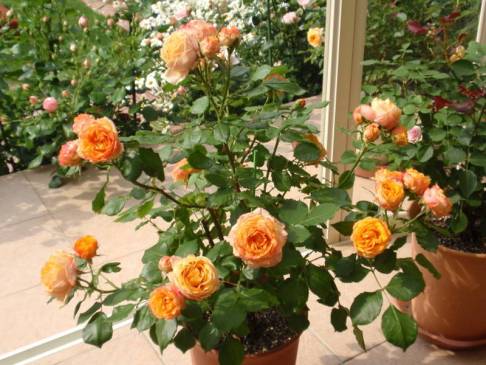
Densely blooming rose Baby Carnival
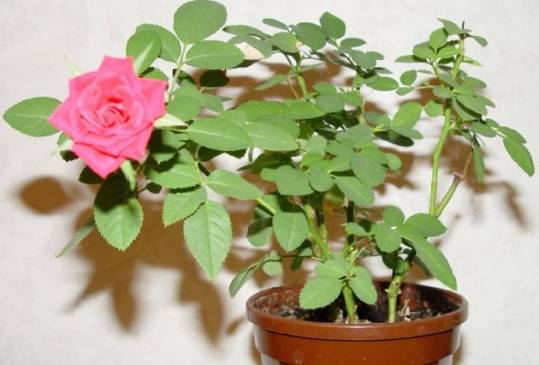
Elegant and unpretentious rose Eleanor
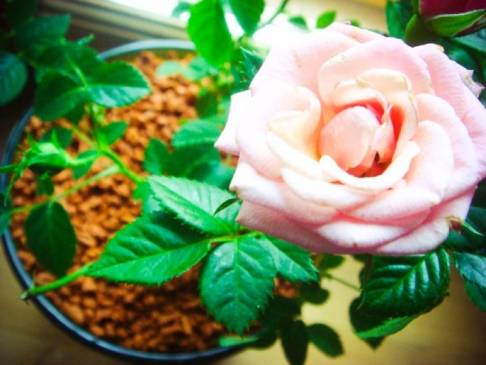
Tender and charming Pixie
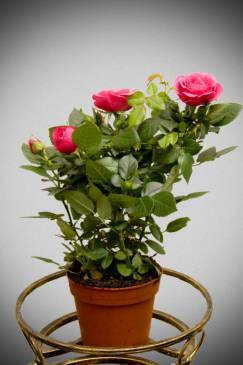
Abundantly flowering variety Coraline
Caring for indoor roses
Watering
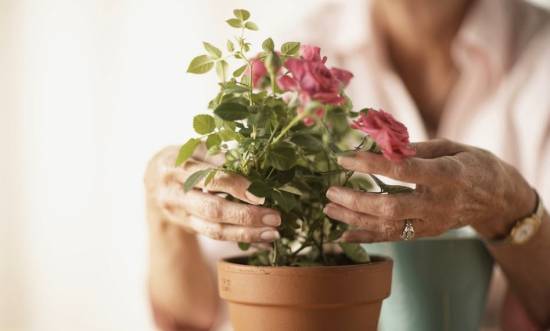
At different times of the year you need to change the intensity of moisture
At each stage of its development, a rose needs different intensities of watering. In spring, its dormant period ends. At this time, as new leaves form, watering is gradually increased. If previously 50-100 ml of liquid per day was required, then later you will need 100-150 ml per bush. But here it is important not to overdo it: excessive moisture has a negative effect on the root system of the plant and can lead to its rotting.
Important! Roses tolerate water deficits more easily than excess water.
During the watering process, you need to monitor the condition of the crop in order to understand whether care is being carried out correctly. There are several signs that indicate errors have been made:
- The appearance of small white insects on the soil surface.
- The soil becomes slippery to the touch and begins to emit a sour smell.
All this indicates overflow. To correct the situation in the first case, it is enough to reduce the amount of water. The second requires more significant measures. The flower must be immediately transplanted into new soil, having thoroughly washed its roots. Moreover, this must be done immediately after the problem is discovered, otherwise the rose will die.
With the onset of summer, the amount of watering should be increased. During this period, active development of flowers occurs, and the crop needs a large amount of moisture (up to 200 ml per day). The plant also needs water for cooling. In mid-August, watering begins to be reduced. But if the rose still continues to bloom profusely, it is moistened as before until the flowering becomes less intense.
Watering requires special attention at the end of September and the first half of October, when the temperature drops. Drying of the soil slows down, and the likelihood of overflowing increases. In winter, moisture is kept to a minimum. The frequency of watering depends on the temperature: the colder it is in the room where the rose is located, the less often you need to add water.
The temperature of the liquid used should also be taken into account. In summer, it must be warm, otherwise a sharp change in temperature level will lead to damage to the roots. For the same reason, in winter the plant is watered with cold water. There is also the possibility of premature growth of the crop. You can use snow that is placed in a pot on the surface of the soil. Tap water should not be used; it contains a high concentration of chlorine, which negatively affects the health of the plant.
Important! Water should only be used that has been filtered or left to sit for 24 hours.
Top dressing
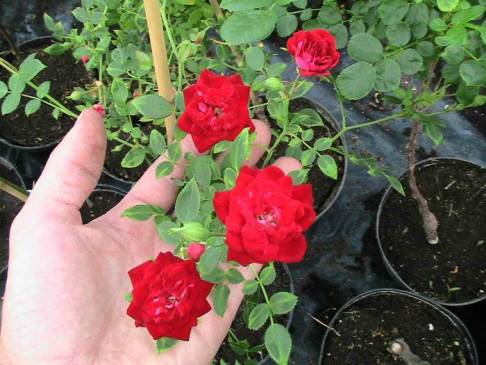
Good feeding is the key to beautiful flowering
In order for a rose to fully develop, it needs to be fed. For this purpose, fertilizers “Pokon”, “Effect”, “Ideal” are used. Preparations are diluted at the rate of 2 caps per 1 liter of water. Used once every 7-10 days. The fertilization process has the following features:
- Before applying fertilizing, water the soil abundantly with water. Applying fertilizers to dry soil can cause burns to the root system.
- The transplanted flower begins to be fed 14 days after it is moved to a new container. The plant should begin to grow.
- In autumn, roses are treated with compositions with a reduced nitrogen content - “Bonsa”. The product is diluted with water in a ratio of 1.5 ml per 1 liter.
- When the plant is in the stage of active development, it requires more feeding. When growth slows, the frequency of application is reduced.
- You should always adhere to the recommended dosage.
Important! It is better to add less composition than to salt the soil with an excessive amount of mixture.
You can also fertilize roses with organic substances. Bird droppings or manure are suitable for this purpose. Natural fertilizer is prepared as follows:
- The droppings are filled with water and left for 10-12 days.
- After this time, the composition is filtered and diluted with water.
- The ratio of components depends on the type of fertilizer. Manure from farm animals is diluted at the rate of 1 part of the mixture to 5 parts of water. Bird droppings are diluted in a ratio of 1:10.
Transfer
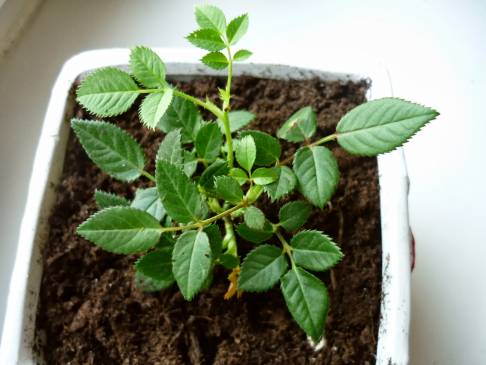
When transplanting, it is important to follow the order of actions
The rose can be replanted in the first half of spring. The new pot should exceed the previous one by 3-4 cm in diameter and 5 cm in height. The process is performed according to the following algorithm:
- First, you need to water the crop and wait until the moisture is absorbed.
- Then the container with the flower is turned over and shaken a little, holding the rose with your hand.
- A 1 cm thick layer of drainage is poured onto the bottom of the pot (expanded clay is used for this). If there is no drain hole, the layer thickness should be 4 cm.
- Then the plant is placed in a new container and covered with soil. You need to leave a distance of 2-3 cm between the surface of the soil and the edge of the pot. The rose requires nutritious soil. The soil mixture should consist of sand, humus and turf soil. The components are mixed in a ratio of 1:4:4. In specialized stores you can find ready-made “Rose” composition.
- The transplanted culture is placed for a day in a shaded place or on the north side. The leaves of the plant can be sprinkled, but you cannot water it right away. After 24 hours, the rose is placed on the east or south side.
Important! To avoid overheating of the flower at high air temperatures, the pot is placed in a tray with water on a stand.
Video: Master class on replanting indoor roses
How to trim
There are three types of pruning:
- light;
- moderate;
- strong.
The first method involves removing two-thirds of the stem length. This pruning is used for vigorous varieties. You should not use this method continuously for several years, otherwise the bush will become very elongated and will bloom poorly.
Moderate pruning involves removing half the length of the stem. Suitable for mature shrubs.
With severe pruning, the shoot is removed in the area of the third or fourth bud from the base. This method is used for newly planted bushes. It is not recommended for use on adult plants. The exception is weak shrubs that need rejuvenation.
Video: Instructions for pruning a flower
Care after flowering
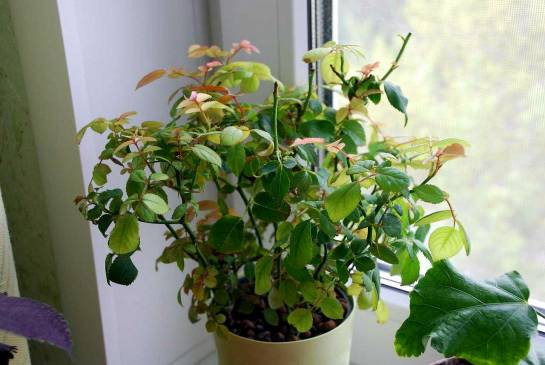
The rose must be pruned before resting.
After flowering, the rose begins to prepare for dormancy. Watering should be reduced and the dosage of fertilizers applied should be reduced. The plant is placed in a room with a temperature of 15-17°C (the crop cannot be placed near heat sources). Shoots and stems are trimmed so that 5 buds remain on them.
Unpruned shrubs will grow greatly with the onset of active growth, and the size of the flowers will be smaller than expected. This is explained by the fact that blind shoots will take nutrients from the soil.
How to care in winter
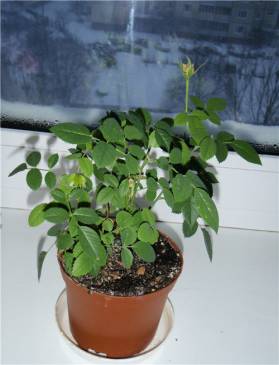
When dormant, you need to reduce watering
The winter season is a dormant period for roses, requiring changes in its maintenance regime. The plant is transferred to a cool place where the temperature is between 6-8 °C. Since apartments are heated at this time of year, the optimal place is a glazed balcony or loggia.
The culture should be in warm soil. To do this, the pot is placed in a box with sawdust. It is necessary to regularly monitor the temperature level in the room where the plant is located. If the reading drops below 6 °C, the rose should be moved to a warmer place. Watering is carried out rarely, only when the soil dries out.
Important! Spraying is not carried out in winter.
The issue of reproduction
There are several ways to propagate roses:
- using cuttings, suckers and layering;
- by dividing the bush.
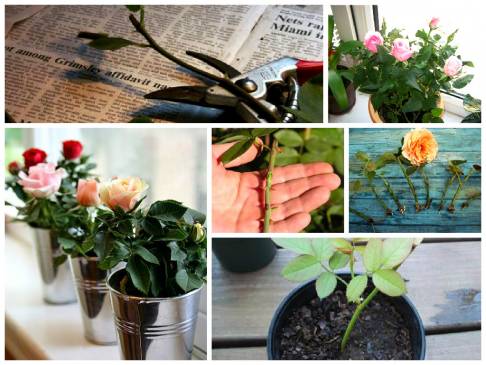
Cuttings are the fastest way to propagate roses
The cutting process has the following features:
- Summer is considered the best period for breeding. Cuttings are cut from the branches; each of them should have 2-3 buds.
- The bottom cut must be made oblique. The kidney should be pointing upward. The top cut is made straight.
- The cuttings are placed in water or a mixture of peat and sand (1:1). It is important to do this before the planting material dries out.
- The water in which the cutting is located should not be poured out, even if the liquid turns green. When the roots appear and reach a size of 1-2 cm, the plant needs to be planted in a pot.
- The sprouts should be placed in a well-lit place, but they should not be exposed to direct sunlight. Cuttings need to be watered periodically. After two weeks, young flowers will appear.
At home, the crop is also propagated by dividing the bush:
- It is recommended to perform this procedure in the spring. The bush is removed from the pot and cut into several parts using a sharp knife or pruning shears. In each it is necessary to preserve several shoots.
- Roots damaged during the digging process are cut back to a healthy area. The shoots are also shortened. It is enough to leave 3-4 buds on each. Small branches are removed.
- The roots are dipped in a clay solution and the crop is planted in a pot.
Important! In order for the bush to form correctly, the upper buds must be directed to the outer or side.
Diseases and pests
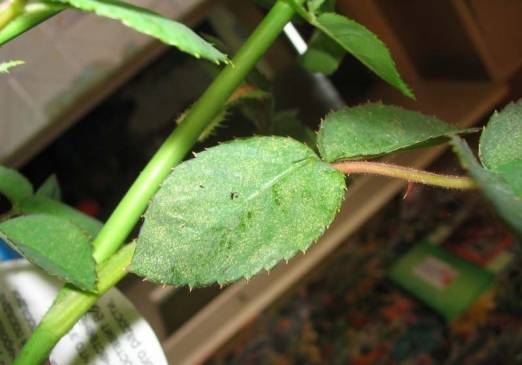
Indoor rose diseases can be caused by improper care
Indoor roses are exposed to various diseases and pest invasions. Among the most common problems we highlight the following:
- The appearance of spider mites. A flower affected by this pest has leaves that turn yellow and fall off. On their bases you can see small cobwebs. A damaged plant may dry out. The tick itself is quite difficult to see due to its small size. The danger of this pest also lies in its ability to transmit infectious diseases. The drugs “Actellik” (1 ml per 1 liter of water), “Fitoferm” (2 ml per 1 liter of water) will help get rid of it. The latter can also be used for preventive purposes, treating the plant 2 times a year (in spring and autumn).
- Formation of powdery mildew. This is a fungal disease that can be detected by a white coating on the leaves of the flower. If left untreated, the plant dies. This disease should be fought with the help of Topaz (2 ml per 5 liters of water). When using, you must observe an interval of two weeks. Prevention is through moderate watering, as the fungus develops in a humid environment.
- The defeat of a flower by “black leg” is a disease that occurs as a result of excessive watering and weakened immunity of the plant. The stems of the rose turn black. The soil is watered with a strong solution of potassium manganese. And also “Fitosporin”, which is diluted with water in a ratio of 1:2. Treatment is effective only at the first stage of the disease; at an advanced stage, the flower cannot be saved.
Growing indoor roses is not particularly difficult. The main condition is compliance with all the rules required for the growth and flowering of the crop. These are temperature conditions, watering, fertilizing, pruning. No less important is pest control, which can be avoided with timely preventive measures.
